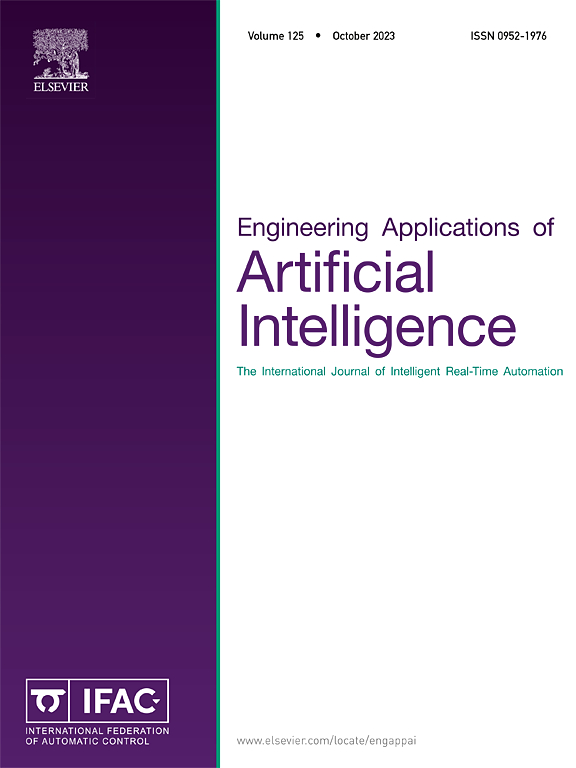A ground-based cloud image classification method for photovoltaic power prediction based on Convolutional Neural Networks and Vision Transformer
IF 8
2区 计算机科学
Q1 AUTOMATION & CONTROL SYSTEMS
Engineering Applications of Artificial Intelligence
Pub Date : 2025-07-03
DOI:10.1016/j.engappai.2025.111582
引用次数: 0
Abstract
Cloud image classification plays a crucial role in accurately predicting solar radiation attenuation, which significantly impacts ultra-short-term photovoltaic power predictions. Despite recent advancements in cloud image classification using Transformer and convolutional neural networks, challenges remain, particularly in handling rapidly evolving cumuliform clouds. To address this, we propose CloudMViT, an improved model derived from a model that combines Convolutional Neural Networks and Vision Transformer (MobileViT). CloudMViT introduces the CloudMobileNetV2 (CMV2) Block, building upon the Mobile Network architecture (MobileNetV2). This block incorporates a triple-branch inverted residual structure consisting of depthwise separable convolution, standard convolution, and shortcut branches, along with a New Multi-scale Channel Attention Module (NMS-CAM). Simultaneously, CloudMViT proposes the CloudMViT Block, which integrates adaptive convolution to enhance local feature representation. CloudMViT improves local and global feature extraction, boosting cloud image classification accuracy. The proposed model was evaluated through ablation studies and comparative experiments on the Tianjin-Normal-University-Ground-based-Cloud-Dataset (GCD) and Tianjin-Normal-University-Ground-based-Remote-Sensing-Cloud-Database (GRSCD). The ablation experiments demonstrate that the modules introduced in CloudMViT significantly improve cloud image classification accuracy. Comparative results show that CloudMViT achieves higher accuracy than other state-of-the-art methods, reaching 91.40% on GCD and 98.25% on GRSCD datasets. Finally, CloudMViT was validated through experiments in conjunction with a photovoltaic power prediction model, achieving a prediction accuracy of 96.70%, which surpasses that of the original model. This further demonstrates that utilizing CloudMViT cloud image classification results enhances the accuracy of photovoltaic power prediction. Moreover, it verifies that improving cloud image classification accuracy can effectively enhance the precision of photovoltaic power forecasting.
基于卷积神经网络和视觉变压器的光伏发电功率预测地基云图分类方法
云图分类对于准确预测太阳辐射衰减具有至关重要的作用,而太阳辐射衰减对超短期光伏发电预测具有重要影响。尽管最近在使用Transformer和卷积神经网络进行云图分类方面取得了进展,但挑战仍然存在,特别是在处理快速演变的积雨云方面。为了解决这个问题,我们提出了CloudMViT,这是一种基于卷积神经网络和视觉变压器(MobileViT)模型的改进模型。CloudMViT引入了基于移动网络架构(MobileNetV2)的CloudMobileNetV2 (CMV2)块。该区块包含一个由深度可分离卷积、标准卷积和快捷分支组成的三分支倒转残差结构,以及一个新的多尺度通道注意模块(NMS-CAM)。同时,CloudMViT提出了CloudMViT Block,该Block集成了自适应卷积来增强局部特征表示。CloudMViT改进了局部和全局特征提取,提高了云图像分类的准确性。通过对天津师范大学地面遥感云数据集(GCD)和天津师范大学地面遥感云数据集(GRSCD)的烧蚀研究和对比实验,对该模型进行了评估。消融实验表明,CloudMViT中引入的模块显著提高了云图分类精度。对比结果表明,CloudMViT在GCD和GRSCD数据集上的准确率分别达到了91.40%和98.25%,高于其他最先进的方法。最后,结合光伏发电功率预测模型对CloudMViT进行实验验证,预测准确率达到96.70%,超过原模型。这进一步证明了利用CloudMViT云图分类结果可以提高光伏功率预测的准确性。验证了提高云图分类精度可以有效提高光伏发电功率预测精度。
本文章由计算机程序翻译,如有差异,请以英文原文为准。
求助全文
约1分钟内获得全文
求助全文
来源期刊

Engineering Applications of Artificial Intelligence
工程技术-工程:电子与电气
CiteScore
9.60
自引率
10.00%
发文量
505
审稿时长
68 days
期刊介绍:
Artificial Intelligence (AI) is pivotal in driving the fourth industrial revolution, witnessing remarkable advancements across various machine learning methodologies. AI techniques have become indispensable tools for practicing engineers, enabling them to tackle previously insurmountable challenges. Engineering Applications of Artificial Intelligence serves as a global platform for the swift dissemination of research elucidating the practical application of AI methods across all engineering disciplines. Submitted papers are expected to present novel aspects of AI utilized in real-world engineering applications, validated using publicly available datasets to ensure the replicability of research outcomes. Join us in exploring the transformative potential of AI in engineering.
 求助内容:
求助内容: 应助结果提醒方式:
应助结果提醒方式:


